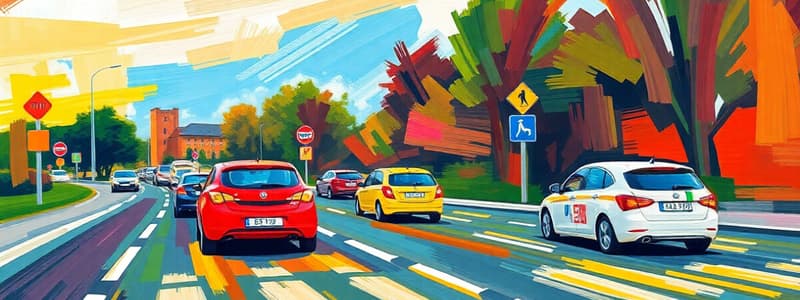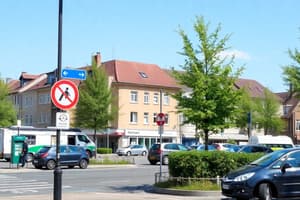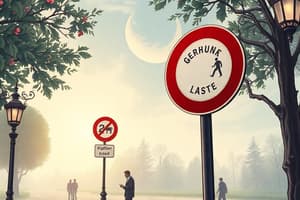Podcast
Questions and Answers
Welche der folgenden Aufgaben fällt NICHT in die sachliche Zuständigkeit der Straßenverkehrsbehörde?
Welche der folgenden Aufgaben fällt NICHT in die sachliche Zuständigkeit der Straßenverkehrsbehörde?
- Die Erteilung von Ausnahmegenehmigungen
- Die Anordnung von Verkehrsbeschränkungen
- Die Verfolgung von Ordnungswidrigkeiten im Straßenverkehr. (correct)
- Die Aufstellung von Verkehrszeichen
Welche Aussage beschreibt den Begriff 'Verkehrsteilnehmer' im Sinne des Straßenverkehrsrechts am besten?
Welche Aussage beschreibt den Begriff 'Verkehrsteilnehmer' im Sinne des Straßenverkehrsrechts am besten?
- Jede Person, die eine gültige Fahrerlaubnis besitzt.
- Jede Person, die sich im öffentlichen Verkehrsraum verkehrsrechtlich relevant verhält und körperlich unmittelbar auf den Verkehr einwirkt. (correct)
- Jede Person, die ein Fahrzeug im öffentlichen Verkehrsraum führt.
- Jede Person, die sich im öffentlichen Verkehrsraum aufhält.
Was kennzeichnet den Unterschied zwischen 'Gemeingebrauch' und 'Sondernutzung' im öffentlichen Verkehrsraum?
Was kennzeichnet den Unterschied zwischen 'Gemeingebrauch' und 'Sondernutzung' im öffentlichen Verkehrsraum?
- Gemeingebrauch ist die Nutzung innerhalb der Widmung, Sondernutzung geht über diese hinaus. (correct)
- Gemeingebrauch ist kostenfrei, Sondernutzung ist immer gebührenpflichtig.
- Gemeingebrauch ist die Nutzung für alle, Sondernutzung bedarf einer Genehmigung.
- Gemeingebrauch betrifft nur Fußgänger, Sondernutzung betrifft Fahrzeuge.
Welche Aussage trifft auf die Hierarchie der Verkehrsregelung zu?
Welche Aussage trifft auf die Hierarchie der Verkehrsregelung zu?
In welchem Fall liegt keine 'unvermeidbare Behinderung' im Sinne des § 1 StVO vor?
In welchem Fall liegt keine 'unvermeidbare Behinderung' im Sinne des § 1 StVO vor?
Welche der folgenden Handlungen erfordert keine Fahrerlaubnis?
Welche der folgenden Handlungen erfordert keine Fahrerlaubnis?
Wann erlischt die Betriebserlaubnis eines Fahrzeugs?
Wann erlischt die Betriebserlaubnis eines Fahrzeugs?
Ab welcher Blutalkoholkonzentration (BAK) liegt absolute Fahruntüchtigkeit bei einem Kraftfahrer vor?
Ab welcher Blutalkoholkonzentration (BAK) liegt absolute Fahruntüchtigkeit bei einem Kraftfahrer vor?
Welche der folgenden Substanzen führt nicht automatisch zur Fahruntüchtigkeit?
Welche der folgenden Substanzen führt nicht automatisch zur Fahruntüchtigkeit?
Welches der genannten Kriterien ist kein typisches Anzeichen für einen möglichen Einfluss von Rauschmitteln bei Verkehrsteilnehmern?
Welches der genannten Kriterien ist kein typisches Anzeichen für einen möglichen Einfluss von Rauschmitteln bei Verkehrsteilnehmern?
Was beschreibt das Ziel der polizeilichen Verkehrssicherheitsarbeit (VSA) am treffendsten?
Was beschreibt das Ziel der polizeilichen Verkehrssicherheitsarbeit (VSA) am treffendsten?
Welche Säulen gehören klassischen zur Verbundstrategie der Verkehrssicherheitsarbeit?
Welche Säulen gehören klassischen zur Verbundstrategie der Verkehrssicherheitsarbeit?
Bei einer Verkehrskontrolle, was ist der primäre Zweck der Eigensicherung?
Bei einer Verkehrskontrolle, was ist der primäre Zweck der Eigensicherung?
Was ist bei der Auswahl eines Kontrollortes im Rahmen der Verkehrsüberwachung besonders zu beachten?
Was ist bei der Auswahl eines Kontrollortes im Rahmen der Verkehrsüberwachung besonders zu beachten?
Was ist die korrekte Definition eines Verkehrsunfalls im Sinne des Straßenverkehrsrechts?
Was ist die korrekte Definition eines Verkehrsunfalls im Sinne des Straßenverkehrsrechts?
Flashcards
Straßenverkehrsbehörde Zuständigkeit
Straßenverkehrsbehörde Zuständigkeit
Sachliche Zuständigkeit für Straßenverkehrsbehörden gemäß § 44 I StVO.
Verkehrsregelungsbefugnis der Polizei
Verkehrsregelungsbefugnis der Polizei
Die polizeiliche Befugnis, den Verkehr zu regeln, wie in § 36 StVO beschrieben.
Verdachtsunabhängige Verkehrskontrolle
Verdachtsunabhängige Verkehrskontrolle
Eine Kontrolle im Straßenverkehr, die nicht auf einem konkreten Verdacht basiert, gemäß § 36 V StVO.
Verkehrsteilnehmer Definition
Verkehrsteilnehmer Definition
Signup and view all the flashcards
Ruhender Verkehr
Ruhender Verkehr
Signup and view all the flashcards
Öffentlicher Verkehrsraum Definition
Öffentlicher Verkehrsraum Definition
Signup and view all the flashcards
Sondernutzung
Sondernutzung
Signup and view all the flashcards
Verkehrsregelung durch Polizei
Verkehrsregelung durch Polizei
Signup and view all the flashcards
Fahren ohne Fahrerlaubnis
Fahren ohne Fahrerlaubnis
Signup and view all the flashcards
Fahren ohne Zulassung
Fahren ohne Zulassung
Signup and view all the flashcards
Auswahlkriterien einer Kontrollstelle
Auswahlkriterien einer Kontrollstelle
Signup and view all the flashcards
Drogenerkennung
Drogenerkennung
Signup and view all the flashcards
Relative Fahruntauglichkeit
Relative Fahruntauglichkeit
Signup and view all the flashcards
Alkohol- und Drogenkontrolle
Alkohol- und Drogenkontrolle
Signup and view all the flashcards
Ziele der Verkehrssicherheitsarbeit (VSA)
Ziele der Verkehrssicherheitsarbeit (VSA)
Signup and view all the flashcards
Study Notes
- The notes are for Verkehrstrecht (Traffic Law), Verkehrslehre für M 2 (Traffic Teaching for M2) for the date 20.02.2025
Responsibilities in Road Traffic
- Responsibility of the road traffic authority according to § 44 I StVO
- Responsibility of the police in GiV instead of the road traffic authority § 44 II StVO
- Police powers to regulate traffic § 36 StVO
- Suspicion-independent traffic control § 36 V StVO for control purposes in traffic (driver, roadworthiness, vehicle, documents)
Definitions
- Street: Roadway, all associated facilities, including airspace relevant to traffic
- Road user: Anyone who behaves in a manner relevant to traffic law, i.e., who has a direct physical impact on traffic; conditions: public traffic area, activities with an impact on traffic
- Static Traffic: deliberate interruption of travel
- Flowing Traffic: Driving or unintentional interruption of travel
Public Traffic Area
- Legally public traffic area: Dedicated to the purposes of traffic
- Factually public traffic area: Released for an indefinite group of users entitled to use it or use is tolerated
- Non-public traffic area: No use or use only possible by a group of users defined by the person authorized to dispose of it. Can also be limited in time
- Common use utilization of the legally public traffic area within the dedication
- Special use utilization of the legal public traffic area beyond the common use
- Definition of public traffic area: All paths, squares, areas that are actually open to traffic purposes for everyone due to a legal dedication or regardless of the ownership
- Delineation name / recognize examples of non-public traffic area
Rules of Conduct
- Corresponding paragraphs of the StVO can be found / recognized as rules of conduct
- Special standards (e.g. speed § 3 StVO), relevant standards are in particular §§ 1-23 StVO (except §§12, 13, 15, 15a StVO
- Know the hierarchy of traffic regulations and be able to apply them using examples; Traffic control by police officers (§ 36 StVO)
- Light signal regulations (§ 37 StVO)
- Regulation by traffic signs (§§ 39 ff StVO)
- General traffic rules (§§ 2 ff StVO), if applicable, subsidiary: general clause § 1/II StVO
- Check whether there is a concrete consequence: Damage, endangerment or more than unavoidable obstruction or harassment in the facts exists
- If this is not mentioned in the special rule of conduct (special standard), observe § 1/II StVO as a general clause
- If there is no special standard, the general duty of care applies in accordance with § 1 II StVO (e.g. rear-end collision without prior failure to maintain a safe distance)
- Determination of elements of an offense and examination of a VOwi according to StVO, including checking whether the respective behavior is an administrative offense and this is subject to a fine. (§§49 StVO, § 24 StVG)
Licensing of Persons
- Participation in traffic in the ÖVR? Does someone behave partially traffic relevant?
- Driving a motor vehicle → Def. Kfz: § 1/II StVG: mechanically driven land vehicle not bound to rails; Driving the Kfz ➔ at least partly performing actions as intended for driving (e.g. reaching into the steering wheel)
- Is a driving license required? ➔ § 2 StVG; § 4 FeV; Moped: if applicable certificate § 5 FeV ➔ from * 1.4.1965 (§ 76 Nr. 3 FeV)
- Driving license class? ➔ § 6 FeV, for older FE ==> scope of validity iVm Annex 3
- If applicable Conditions (personal) or restrictions (vehicle-related)? §§ 2 (general), 3 (vehicle or animal handler), 23 (driving license applicant), 46 FeV (driving license holder) (Annex 9)
- Violation of conditions → VOwi § 75 FeV
- Restriction violation → Offense § 21 StVG
- If applicable VOwi acc. to § 75 FeV, note § 21 OWiG in connection with criminal offenses
- Transitional provisions: § 76 FeV
- If applicable Offense: Driving without a driver's license § 21 StVG: Driving despite no or no sufficient driving license, despite driving ban (do not drive any Kfz), if driver's license is secured acc. to § 94/III StPO
Licensing of Vehicles
- Vehicle or trailer subject to registration? § 1 StVG (> 6 km/h), §§1, 3/I FZV (approval; registration = liability insurance, application, type approval/operating permit, allocation of license plate, registration certificate)
- Registration exemption, § 3/III FZV? → Approved type or individual approval § 4/I FZV
- Expiry of the operating permit, § 19/II StVZO? (Through change: vehicle type, hazard to road users to be expected, exhaust or noise behavior deteriorated) → Consequence: for vehicles subject to registration → VOwi acc. to §§ 19 II, V StVZO, for vehicles exempt from registration → VOwi acc. to § 4/I FZV
- Official license plate? ➔ §§ 3/I, 4/II, 8 ff FZV (old: §§ 18/I, IV, 23 StVZO)
Alcohol and Drugs
- Where and when to check: Selection criteria of a checkpoint, ....music events, festivals, "Promillewege" (alcohol routes), citizen information..., terms "target group-oriented, location-oriented"
- Drug detection: Behaviors / consumables, vehicle person, SFT test (overview), drug pretest's (e.g. Drugwipe, MMC (ESA)), classifications drug: sedatives, stimulants, hallucinogens, euphorics
- Driving Implausibility / Terms
- Absolute driving unfitness: for alcohol 1.1‰ BAC for car drivers, 1.6‰ BAC for cyclist
- Relative driving unfitness: from 0.3‰ BAC or intoxicant + signs of failure (intoxicant-related)
- Manifestations: Intoxicant-related misconduct in road traffic or for drugs also drug-typical physical appearance. But not just individual physical abnormalities
- Owis (§ 24c StVG)
- 0.0 %o for novice drivers (under 21 years of age or during FE on probation) no alcohol or Measuring tolerance 0.2 %).
- THC > 1 ng/ml, Owi: & 24a StVG
- only car drivers: from 0.5% BAC or 0.25mg/l AAK
- THC > 3.5 ng/ml,
- Intoxicants according to Appendix to the StVG (> Measuring limit values, see Annex / TBK, THC + Alcohol; Corresponding TB can be found in TBK / Explain differences
- Offenses: § 316 StGB: intoxication as an abstract endangerment offense
- Evidence: In VOwi according to § 24a I StVG calibrated breath alcohol analysis (Dräger Evidential 9510 (AAK) > 0.25 mg/L breath; in the criminal area > 0:3‰ BAC or for drug influence always blood sampling according to § 81a StPO
- Suspicion Obtaining Narcotic-Influenced Persons: You should think about these people at every deployment, every check or every accident, at this time, in this place and setup and outfit
- Additional steps that should be taken are in the vehicle in connection with their information; the result of these considerations makes a contribution to a meaningful selection
Special Search Patterns for Drug-Influenced Road Users
- Ross-Reiter theory (often parents or acquaintances as keepers, high-quality vehicle and too young driver),
- Vehicle and too young driver)
- Junk in the car: many empty cans (especially energizing drinks, many cigarette packs)
- Backpacks ("Müllsäcke") in the PKW
- red conjunctivae without alcohol odor
- Sunglasses without sun
- Driving errors without alcohol odor
- Failures of behavior without alcohol odor
- Suit wearer, but casual clothing rules (too flippant)
- Exalted, situationally inappropriate or intolerant behavior
- Holder INPOL inconspicuous / car rental (especially for couriers)
Auffälligkeiten bei Personen unter Alkohol
- Physically neurological, vision performance reduction, Restriction of the field of view, the fixation, Impairment of vision/ sharpness of vision, and motion vision, considerable impairment in outward Rolling of the eyes, strabismus (Diplopia),
- Decreased depth perception - > Problems in estimating the distance; Problems in Blend sensitivity, Twilight vision and Readaption after glare,
- Mental performance impairments, other negative effects on: Balance organs and muscle coordination
- Grown language, insecure gait
Intoxication as Causes of Accidents or Types of Accidents
- Glare as a cause of accident
- Deviation from the lane on straight stretch / curve
- Collisions on the lane edge
- Collisions with oncoming vehicles when turning
- Rear-end collisions
- Accidents when overtaking or by extremely inappropriate speed
- Bumping when parking and parking ("Parkrempler") in the wrong lane
- larger Section driven a greater distance the wrong
- Missing brake / steering reactions
- Without reaction to the accident continued
- Not Observed incomprehensible traffic signs (e.g. rail barriers)
Physical Test (Voluntary)
- E.g. pupillary reaction, coordination test, question test
Foundations of Police Traffic Safety Work
- The Goals of Traffic Safety Work: (Minimizing Accident of Risk, to guarantee Mobility),
- Compound strategy: the traffic safety work relies classically close to the columns of the so-called 3 E's + OA: i. (Education = the traffic-safety education, traffic safety advising, enforcement = engineering = traffic Technologies and traffic space design, the Public Relations = public relations, optional Economy),
- To understand what that Traffic Union strategy understand, who is are our partner ( Stakeholder) in it the VSAs, the naming of example of that Vehicle Traffic Safety (60 – 70% of all protection police actions are in Combine with the Traffic
- Almost all Offences have Reference to that street Traffic
Risk Groups in Traffic Safety Work (Rising Risk)
- 45-50 year olds, Other in the Old of 25 to 65 Years, Children (Focus: Victims), Seniors, Youth, Young drivers
Traffic Controls Purposes
- To cause road users to behave in a traffic-appropriate and prudent manner
- Preventive effect through the presence of the police
- Prevention of traffic accidents, obstructions, nuisance, harmful environmental influences
- Holistic Control → also aspects of crime control, like smuggling, Trafficking and transport of stolen goods
Priorities Aims
- Complete traffic control is neither possible nor desirable The prevention of vehicle traffic accidents (Speed violations , priority, traffic lights systems, usage of streets, passing, Abbiegen, Distance and Pedestrians at the to walk across the street , Alcohol u Drugs
- Prevent obstructions of flowing Traffic and from other Pedestrian traffic
- Prevent obstructions of Flowing Traffic and by other Pedestrian traffic
Own Securing in Traffic
- Measures to secure self protection according to LF 371
Intervention for Traffic
D. Intervene According to Mandatory Discretion
- Opportunity Principle (§§ 47, 53 OwiG), on Suspicion of Criminal Offence legality Principle According to § 163 StPO: It is not guaranteed that every traffic offense must be followed. The police may generally or in individual cases refrain from prosecuting, as it applies to mandatory discretion
- Due to the Principle Mandatory Discretion (Equality, Proportionality
- Consideration of The Aims of the traffic
- Exercising Discretion is mandatory if, then that mandatory Legal principles Note Rechtliche KontrollbefugnisseLegal Authority
- Legal authority or Right of Power of Review: § 36 V StVO § 44 II StVO
Implementation of Traffic Supervision (Traffic Policing)
- Scope of the VÜ (Traffic Policing of Jurisdiction a. Vehicle Driver (Behavior) i. Driver (condition driving, licensing driving, ii. Vehicle and it´s documents b. Traffic signs location conditions and more
Control Check
- Division into an interior (Interior of the car, passengers) u. outer control area (car exterior, vehicle technology) mind. 2 controllers a. Drivers checks or Documents, Drivers documents License
- Driving license vehicles to be secure it and license to drive.
Studying That Suits You
Use AI to generate personalized quizzes and flashcards to suit your learning preferences.



